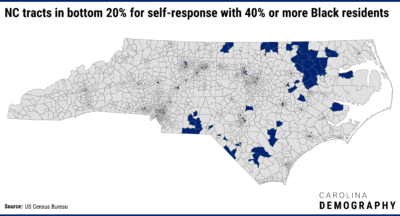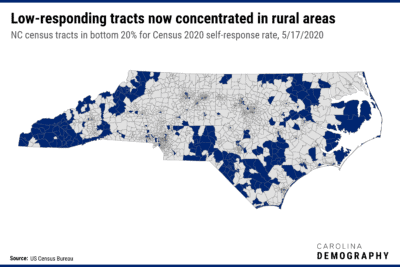More than four in every 10 North Carolina households have not yet filled out the 2020 Census, representing more than 4 million North Carolinians not currently captured in the Census. Our current response rate is below the national rate and below where our state was in 2010. North Carolina communities that have not responded at high rates are predominantly rural, Black, and Brown, with low internet access.
It is vital to our state that all North Carolinians be counted: the 2020 Census ensures our state receives its fair share of more than $1.5 trillion in federal dollars from census-derived programs ($44 billion to NC in FY2017) and that these and state funds are distributed fairly across the state.
The Census is also the foundation of our representative democracy; we are expected to pick up a 14th seat in the U.S. House and Census data will inform where that district is drawn, as well as the allocation of state House and Senate seats and everything down to local school board districts.
Every household that doesn’t fill out the census form online, by mail, or by phone — known as “self-response” — enters the Census Bureau’s non-response follow-up (NRFU) universe. During NRFU, the Census Bureau sends trained enumerators door-to-door to collect census responses directly. This is an expensive and time-consuming process. NRFU was supposed to start in May 2020 but has been delayed due to COVID-19.
NRFU operations are beginning in North Carolina next week and will now continue through September 30, 2020, a month shorter than the initial extension. Ending operations early jeopardizes the completeness and accuracy of the Census, putting North Carolina communities — and the state overall — at risk of being underrepresented and underfunded for the decade to come.
How can we understand which communities are impacted by NRFU?
To understand which communities will be most impacted by NRFU, we examined shifts in the tracts with the lowest self-response (bottom 20%) and compared low response rates on March 20 with the lowest responding tracts as of August 3. (The bottom 20% is a fluid group. The tracts in the bottom can change week to week as certain communities increase their response rates.)
After identifying the bottom tracts, we used the 2018 5-Year American Community Survey data to understand who lives in these tracts, with an eye to answering: are historically undercounted groups becoming more concentrated in the low-responding tracts?
Defining the bottom 20%
There are 2,195 census tracts in North Carolina. Of these, 29 either have no residents or do not have population in households, meaning that we are not tracking them during the self-response phase. When we split the remaining 2,166 census tracts into 5 groups to understand the bottom 20%, this means that there should generally be about 433 census tracts in the bottom 20% (sometimes this number will fluctuate if multiple tracts have the same response rate.)
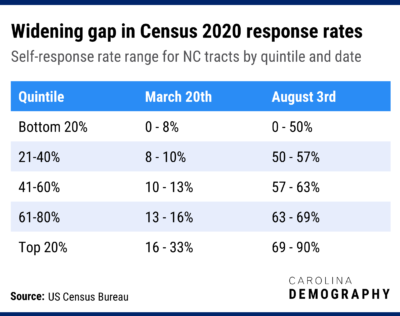
On March 20, there were 436 census tracts in the bottom 20%. These tracts had a self-response rate less than 7.8% — 3.8 percentage points below the state average of 11.6%. Because this was early on, we don’t see much concentration: the bottom 20% of tracts in self-response had 19% of the population and 19% of housing units.
When we look at them on the map, there appears to be some concentration of low-responding tracts in the western part of the state, but there is no clear geographic pattern overall.
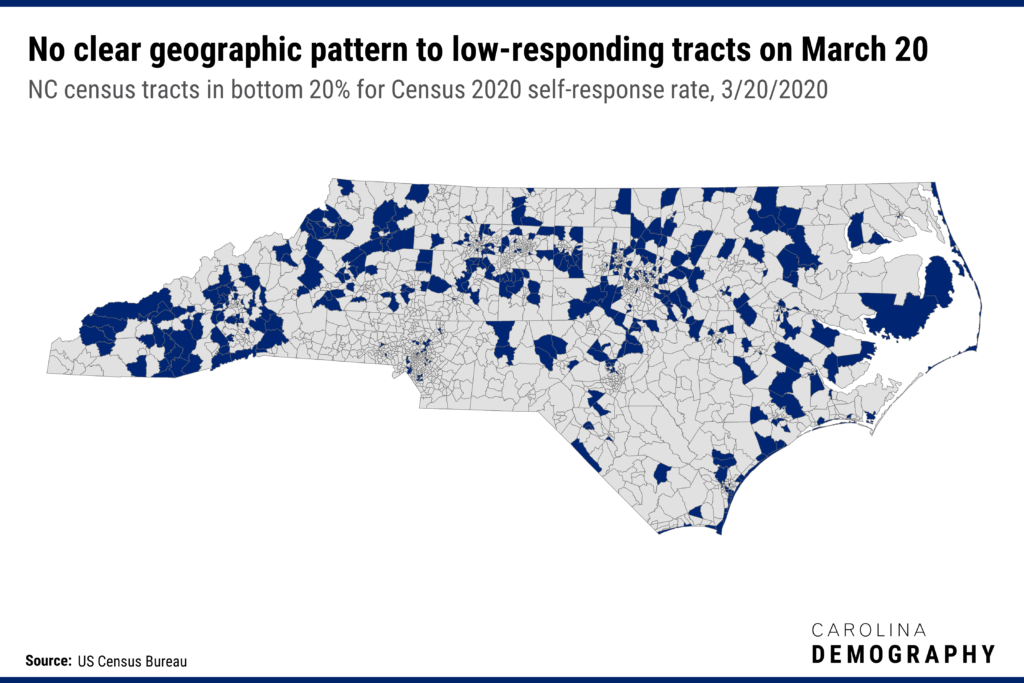
As of August 3, the differences in response rates between the bottom 20% of tracts and the state have increased: less than 50% of households had responded to the census in the lowest-responding tracts, 9.1 percentage points below the state average of 59.1%. The tracts that are in the bottom 20% are now more rural, so they contain fewer residents and households overall: 16% of North Carolina’s population lived in one of the low-performing tracts as of August 3.
There are also clear geographic patterns emerging: the lowest-responding tracts are heavily concentrated in western North Carolina, the Sandhills, and the northeast. These low-response patterns overlap with areas with low internet access and where field operations were suspended due to COVID-19.
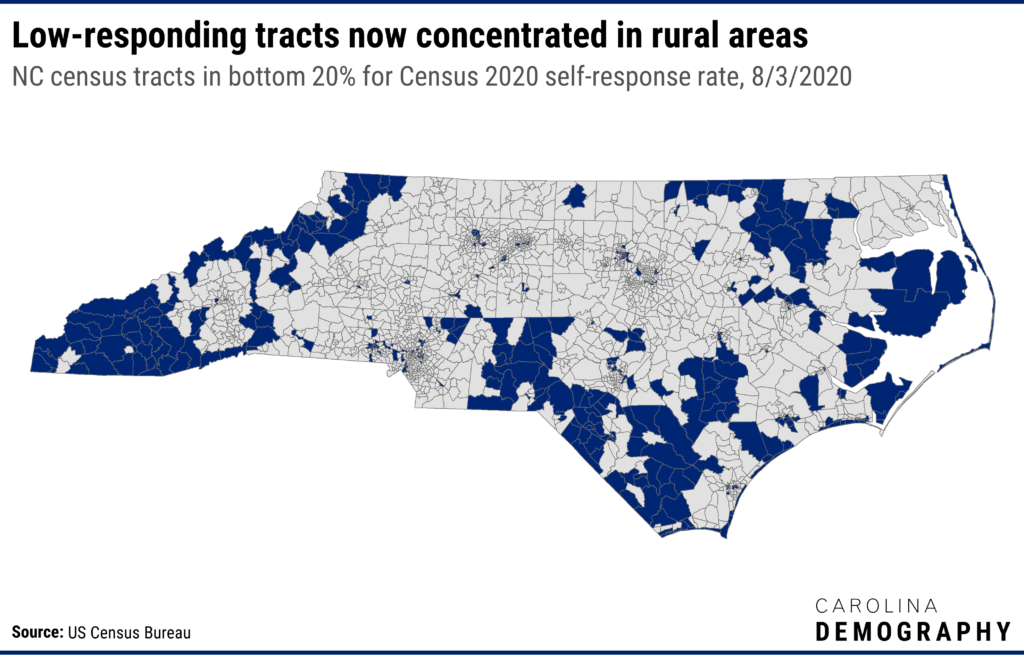
Population shifts
The total number of people living in the lowest-responding tracts as of August 3 was less than the total population living in these tracts on March 20: 1.66 million, down more than 290,000 or -15% from 1.96 million on March 20. In other words, the tracts that are in the bottom 20% more than four months into census reporting are more sparsely populated and rural than the tracts that were in the bottom 20% on March 20.
This was not the case for all racial/ethnic groups. Examining the population in the lowest-performing tracts on March 20 and August 3, the:
- White population in these tracts decreased by 466,000 or -35%
- Black population increased by more than 135,000 or 40%
- American Indian population more than doubled, increasing by 39,300 or 154%
- Asian population decreased by 13,000 or -30%
- Other/multiracial population decreased by more than 7,000 or -16%
- Hispanic population increased by 21,000 or 12%
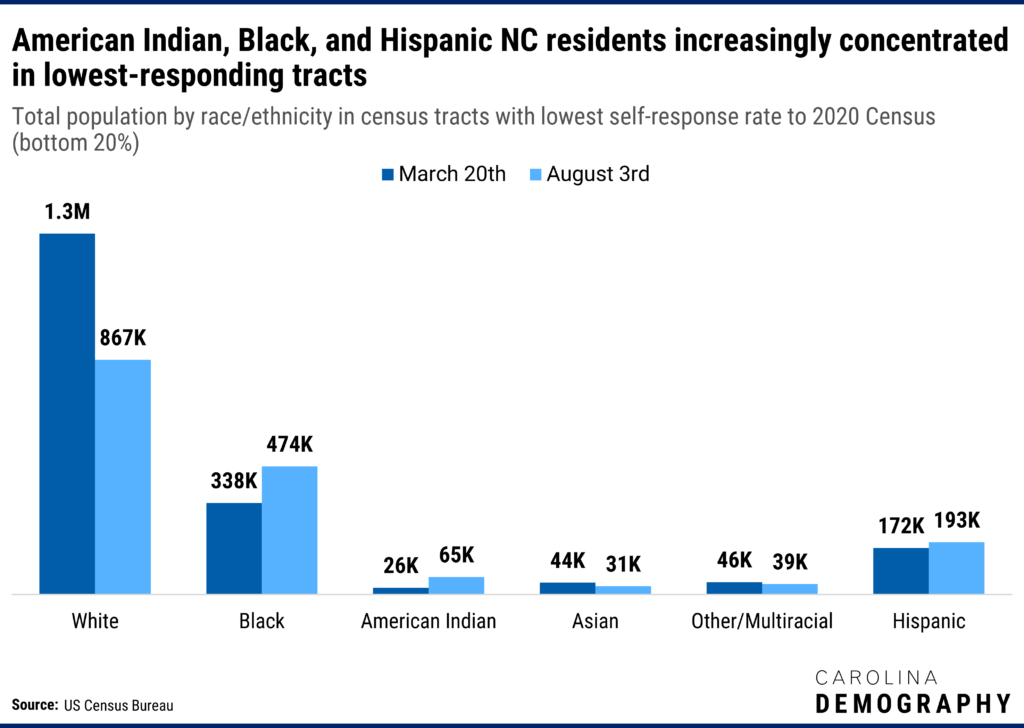
We are now seeing that the individuals living in the lowest-responding tracts are increasingly likely to be minority residents. On March 20, just over one in four (27%) of residents in the lowest-responding tracts identified as American Indian, Black, or Hispanic/Latinx. As of August 3, this proportion had increased to 44%.
Many of the communities in the lowest quintile have been hard hit by COVID-19. Some of these communities, such as Robeson County and parts of the northeast, have felt significant impacts from Hurricanes Florence and Matthew. With hurricane season in full force, these communities are now at risk of displacement just as Census Bureau workers are going to begin going door-to-door with NRFU.
North Carolina has about seven more weeks to ensure that all North Carolinians are counted in the 2020 Census. This data will shape our state for the next decade, ensuring that our communities are fully represented and receive their fair share of funding necessary for everything from roads to K-12 schools and responding to disasters, such as COVID-19 and hurricane recovery.
What can you do?
- Make sure you have completed the 2020 Census. You can respond to the Census online at My2020Census.gov, over the phone by calling 844-330-2020, or through the paper questionnaire received in the mail.
- Ask your friends and family members if they have completed the 2020 Census.
- Send a note to your neighborhood listserv, NextDoor community, or Facebook group.
- Ask your religious institutions, schools, and other community facilities if they can remind people to fill out the 2020 Census using their displays.
- Write to local newsletters you receive and ask them to add a paragraph about the Census.
Editor’s note: This perspective was originally published by Carolina Demography. It has been posted with the author’s permission.


